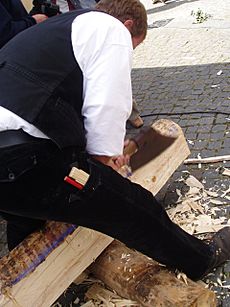Hewing facts for kids
In woodworking, hewing is the use of an axe to make a log into lumber. It is a very old way of making lumber, and was used in ancient times. Before the industrial era it was the normal way to make wood beams. Today it has mostly been replaced by sawmills, but is in some use.
Contents
Definitions
Hew is a word that means to strike, blow, chop, or gash with a tool such as an axe or sword. It is used in warfare, stone and wood cutting, and coal and salt mining. This is the root word for hewing.
Hewing wood is to shape a log with a sharp item such as an axe with the goal to flatten one or more sides.
Methods
As hewing has been used since ancient times, more than one way has been made to do each step. But in general, there are four steps in the process.
Prepare log
The first step is to prepare the log (or tree trunk). After a tree is selected and cut down, hewing can be done at the place where the log landed. Or the log can be moved out of the woods to a work site. The log is then usually placed across two smaller logs. It is kept steady by notching the support logs or by a long bar of iron with a tooth on either end. Then the person doing the hewing measures where to cut and marks lines along the log. These are usually done with a chalk line.
Scoring
The next step is to make notches every foot or two of the log. These are made almost as deep as the marked line. This is called scoring. There are at least three methods that can be used in scoring.
- Standing on the log and swinging an axe to make the notches.
- In Germany a method is used that includes two carpenters standing on the ground. This requires the log to be on trestles. They can then swing downward to make the scores.
- A chainsaw can be used to notch the log.
Joggling or juggling
The next step is know as either joggling or juggling. In this step the pieces of wood between the notches are knocked off with an axe. The result is a rough surface cut down almost to the marked line. The steps to this point remove a much wood and make the last step hewing easier.
Hewing
The last step is called hewing. (The entire process is called hewing as well). This step is done on the sides of the log using a broadaxe. Hewing is started from the bottom of the trem stem upwards toward what was the top of the tree. This reduces the risk of broken fibers that may move inwards toward the beam.
It is also possible to use an adze to hew the top surface of a log. In the past, shipbuilders often used adzes to shape ship timbers. The choice of tool (either axe or adze) was made based on the position of the log to hew. The sides are best hewn with an axe and the top best hewn with an adze.
After the hewing is done, other tools are used to make the surface smooth. This can be done with a hand plane, drawknife, or yariganna.
Modern uses
Some people still used hand-hewn beams in modern building, but it is very rare. A more common use is the re-use of old hand-hewn beams taken from old buildings. They are also popular as decor in some buildings.
Images for kids
-
In some medieval Scandinavian buildings a special method of hewing which produces a herringbone pattern on the timbers has been used (Swedish: Slinthuggning, Norwegian: Sprettejling). This is a modern reconstruction in Stråsjö Chapel in Hälsingland, Sweden.
See also
 In Spanish: Labrado artesanal para niños
In Spanish: Labrado artesanal para niños




